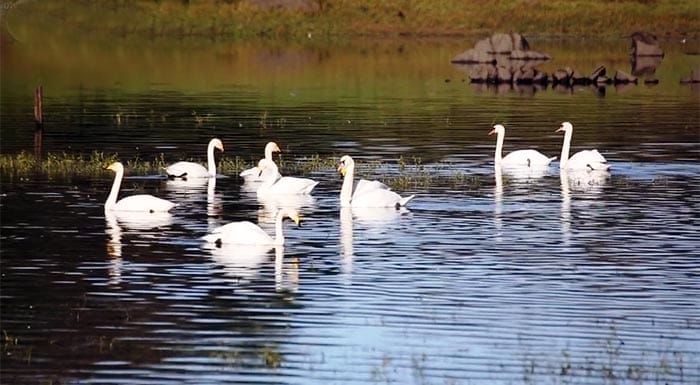By Cristina A. Montes
I suspect that many people are birders without them knowing it. Many people, even without having been taught to identify species, tick off lifers, and keep counts, find entertainment just watching wild birds.
I do not know if the poet William Butler Yeats was an “official” birder, but judging from his poem “The Wild Swans at Coole”, something about those wild swans fascinated him.

(1865-1939)
In the first two stanzas of the poem, we read about someone who has been observing the flock of 59 wild swans at Coole for nineteen years already:
“The trees are in their autumn beauty,
The woodland paths are dry,
Under the October twilight the water
Mirrors a still sky;
Upon the brimming water among the stones
Are nine-and-fifty swans.
The nineteenth autumn has come upon me
Since I first made my count;
I saw, before I had well finished,
All suddenly mount
And scatter wheeling in great broken rings
Upon their clamorous wings.”
Whether that someone was Yeats himself in real life or a character he created, we do not know. But Yeats must have probably experienced it – or something similar to it – to have been able to write about it.
The speaker in the poem did not just count the swans. If we read the rest of the poem, we read that his or her observation of the swans triggered certain emotions and elicited insights, such as melancholy at the fleetingness of things, as well as reflections on the contrasts between youth and old age and on how both sometimes seem to coexist:
“I have looked upon those brilliant creatures,
And now my heart is sore.
All’s changed since I, hearing at twilight,
The first time on this shore,
The bell-beat of their wings above my head,
Trod with a lighter tread.
Unwearied still, lover by lover,
They paddle in the cold
Companionable streams or climb the air;
Their hearts have not grown old;
Passion or conquest, wander where they will,
Attend upon them still.”
I can put myself in the speaker’s shoes watching those wild swans and having a mixture of thoughts and emotions within. Missing the swans, knowing they will fly away someday. Admiring the swans’ sense of adventure and their fidelity to their mates. Identifying himself or herself with the swans, perhaps longing to join them in their travels. And many other possible thoughts and feelings suggested by the images described in these two stanzas.

Indeed, birding – for that matter, communing with nature – shows us things about ourselves too. These observations may not be relevant to ornithologists, but like bird counts, they are also worth recording in a journal entry, poem, or any other genre.
But then again, a case may also be made for simply enjoying the moment of being with the birds. As the last stanza of the poem says,
“But now they drift on the still water,
Mysterious, beautiful;
Among what rushes will they build,
By what lake’s edge or pool
Delight men’s eyes when I awake some day
To find they have flown away?”
Note: The text of “The Wild Swans at Coole” was taken from https://www.poetryfoundation.org/poems/43288/the-wild-swans-at-coole.
